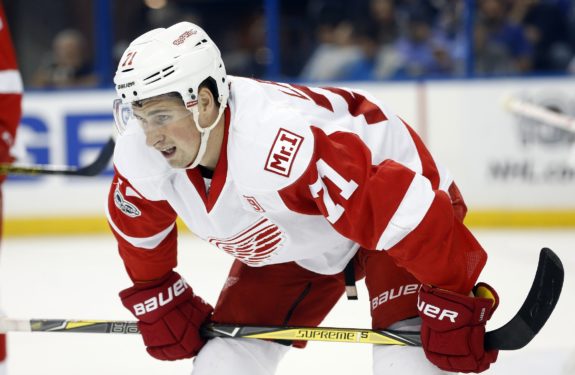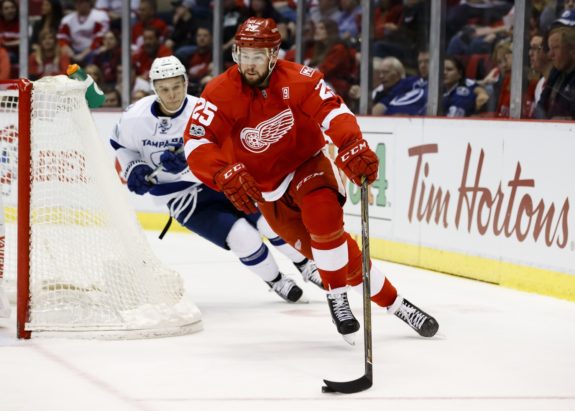If you think the Detroit Red Wings were in a bad spot this offseason with regard to their salary cap issues, just wait until next summer. The 2018 offseason is setting up to be the worst yet for Ken Holland and the Red Wings.
Detroit’s present situation is not enviable. The team is right up against the salary cap upper limit with Johan Franzen and his $3.95 million cap hit already on long-term injured reserve. And apart from adding veteran defenseman Trevor Daley, not much was done to improve one of the NHL’s worst teams this summer.
But when compared to the upward battle Holland will face next summer, this offseason’s follies don’t seem so bad. Here’s why:
Raises for Red Wings’ RFAs
Like Andreas Athanasiou this summer, a number of prominent Red Wings players will be up for new contracts next offseason – and it will cost Hockeytown substantially.
Headlining the group up for raises will be Dylan Larkin and Anthony Mantha, who will be coming off of their entry-level contracts. While the two will not be demanding Connor McDavid superstar money, their next contracts will come with a higher AAV than most recent Red Wings bridge deals. If Larkin continues his strong 2017-18 campaign and Mantha takes another step forward in his development, Detroit’s on-ice future will brighten, but their cap situation will certainly worsen.

In addition to Larkin and Mantha, Petr Mrazek, Tyler Bertuzzi, Martin Frk, and Athanasiou again will need new deals as well. While Bertuzzi and Frk’s next contracts may not come with a high price tag, new deals for Mrazek and Athanasiou likely will. Of course, Mrazek will need to rebound from abysmal 2016-17 seasons first before commanding a raise like Mrazek.
Based on the group performing up to their abilities and recent contracts signed across the NHL, here’s what Larkin, Mantha, Mrazek, and Athanasiou could be looking at when their new deals have been inked:
| Player | 2017-18 Salary | 2018-19 AAV Projection | Raise Amount |
| Dylan Larkin | $925,000 | $4,750,000 | $3,825,000 |
| Anthony Mantha | $832,500 | $4,750,000 | $3,917,500 |
| Petr Mrazek | $4,150,000 | $4,500,000 | $350,000 |
| Andreas Athanasiou | $1,387,500 | $3,000,000 | $1,612,500 |
Just with these four players alone, the Red Wings can expect to add nearly $10 million to the payroll next summer. And considering the recent contracts signed by Viktor Arvidsson, Mikael Granlund, Nino Niederreiter, Alex Galchenyuk, Jean-Gabriel Pageau, Steve Mason, Robin Lehner, and others, these new AAVs are certainly conceivable.
But how can Detroit afford these raises?
Finding Cap Space
Given these expected contracts, Mike Green’s tenure in Hockeytown appears to be reaching its conclusion. He’s provided the offense Detroit has clamored for since Nicklas Lidstrom retired, but is a liability in his own end and is not part of the long-term future. If the Red Wings do not move him at the trade deadline, expect Detroit to let the veteran walk next offseason.

In addition to trading Green, the Red Wings could move another player or two to open up space and continue the rebuilding process. However, Green is the only “rental player” on the roster – a stark difference from the 2016-17 team that moved pending free agents Thomas Vanek, Brendan Smith, and Steve Ott at the deadline. With that in mind, Gustav Nyquist and Jimmy Howard appear to be non-rental trade candidates, but probably wouldn’t bring back enough to match Detroit’s internal value of the two. Auctioning off players to open up cap space is never ideal, so the Red Wings will likely deal these players only if the price was right.
Detroit could also find a way to place one or both of Niklas Kronwall and Jonathan Ericsson on long-term injured reserve to save cap space. The pair have their own chronic injuries to deal with and may decide to preserve their health rather than subject their bodies to another brutal campaign. Detroit shouldn’t need to rely on chronic injuries to get out of salary cap jail, but as we’ve seen with Chicago and Marian Hossa this summer, anything is possible. But thus far, the two have been healthy for the Red Wings, so some actual injury would need to occur.
Finally, the NHL could raise the salary cap upper limit following the 2017-18 season. Another $2-3 million or so in space will help, but more would still need to be done to become cap compliant.
Final Word
Unless Holland takes steps soon to avoid disaster next summer, the Red Wings will be in a world of hurt once this season comes to a close. Adding $10 million to the payroll from raises alone is a tough pill to swallow. And chance are, Detroit will want to improve the team through external sources as well. Something—if not many things—needs to happen to clear up cap space. Detroit’s GM should start preparing now or else the little leverage that he has will quickly go away.